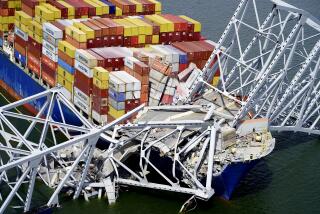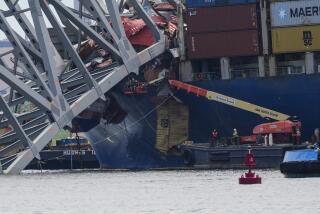Bridge urgency has buckled
CHICAGO — A year after the collapse of Minneapolis’ Interstate 35W bridge, which killed 13 people and injured more than 100, the drive to improve the safety of the nation’s bridges has faded amid waning public interest to fund such projects in a souring economy.
“The push to repair bridges and our country’s infrastructure has become a victim of the bad economy,” said Pennsylvania Gov. Edward G. Rendell, a Democrat who, along with California GOP Gov. Arnold Schwarzenegger and others, is calling for more federal aid to repair deteriorating highways and bridges. “If we don’t put money into our roads and bridges and infrastructure, our economy will get even worse. We won’t be able to transport anything across this country.”
Of the nearly 600,000 public road bridges listed in the Federal Highway Administration’s inventory, about 152,000 are classified as either functionally obsolete or structurally deficient, according to a report released this week by the American Assn. of State Highway and Transportation Officials. Fixing them all would cost about $140 billion, the group found.
Much of the money for bridge repairs on public roads comes from the federal Highway Trust Fund, primarily financed by a federal gasoline tax. But as soaring fuel costs have prompted Americans to drive fewer miles, the fund is dwindling.
Last week, the U.S. House overwhelmingly passed a $1-billion bill to mandate repairs of federal bridges designated structurally deficient, and to require inspections and a list of those that needed help. The bill was sharply scaled back from one introduced soon after the Minnesota collapse. President Bush has promised to veto it.
“That billion dollars is really just a down payment, because we don’t have a true handle of what the costs are going to be,” said bill author James L. Oberstar (D-Minn.).
Earlier this week, the National Transportation Safety Board released new evidence in the I-35W investigation, including a report showing that a gusset plate that connected support beams beneath the bridge had fractured along a corroded section -- a potential concern that state transportation officials had identified at least 15 years ago but had not seen as critical enough to repair.
The board did not draw any conclusions about what caused last summer’s collapse; neither has it ruled out the possibility that the state missed evidence that could have prevented the failure.
The report was released just days before the first anniversary of the Aug. 1 collapse, for which city officials and survivors plan a series of memorials today.
For victims like Karge Olsen -- who suffered two fractured neck vertebrae and a traumatic brain injury and has had six surgeries -- the cooling interest in bridge and road spending feels like a slap in the face.
“Ignoring the problem is only going to make it worse,” said Olsen, 28, of Minneapolis, a telecommunications worker. “It could happen again tomorrow.”
To help shore up the Highway Trust Fund, some observers propose increasing the gas tax, which has remained relatively steady at 18.4 cents per gallon since 1993.
The tax has not increased to match the rate of inflation, said Matt Sundeen, a transportation analyst for the National Conference of State Legislatures, which supports a gas tax increase. He said raising the tax wouldn’t increase the price of gas much because other factors weigh more heavily in the price.
But given the recent spike in pump prices, Sundeen said, it’s difficult for candidates to push plans that would make voters pay more.
That leaves state officials in a quandary, as they increasingly feel that “if they want to solve the problem, they’d best not wait around for Washington,” said Joseph Schwieterman, a national transportation expert and professor at DePaul University in Chicago.
Illinois and Indiana have partnered with the private sector, which has purchased the leasing rights to operate some roadways as toll roads. Oregon is looking for ways to tax vehicles based on the number of miles traveled -- a move that could help generate revenue from fuel-efficient cars whose owners contribute less to the gasoline tax. In New Jersey, Democratic Gov. Jon Corzine proposed increasing highway tolls 50% every four years until 2022 to raise money for transportation work, but his administration is revising the plan because of public and legislative opposition.
In Minnesota, transportation has arguably been the most controversial issue for the last year. Despite GOP Gov. Tim Pawlenty’s veto, legislators passed a far-reaching $6.6-billion plan that promised improved roads and bridges. To help cover the cost they raised the sales tax, vehicle registration tax and state gasoline tax -- the latter for the first time in 20 years.
State officials also scrutinized aging bridges, with transportation officials launching a statewide review of 25 similar in design to the I-35W bridge. Several were temporarily or permanently closed as a result, creating headaches for Minnesotans and their neighbors.
Last month state officials shut down a bridge in Winona, in southeast Minnesota, over concerns that some gusset plates were corroded. The Highway 43 bridge, built in 1941, was regularly used by Minnesota and Wisconsin residents to cross the Mississippi River. Its closure created chaos for more than a week, detouring commuters for dozens of miles and reportedly forcing nearly 2,800 people who use the crossing each day to wait in long lines for a ferry. (The bridge was repaired and reopened to all traffic July 14.)
“People are still complaining about it,” said Beth Cannestra, director of the Wisconsin Department of Transportation’s Bureau of Structures. “But what can you do? Stand by and wait for an accident to happen?”
--
deedee.correll@latimes.com
--
(BEGIN TEXT OF INFOBOX)
Aging infrastructure
The average age of American bridges is 43 years, approaching the normal life span of 50 years. One-fourth have a problem.
U.S. bridge status assessment
Functionally obsolete:
Built to obsolete standards but not necessarily structurally deficient or unsafe; lacking adequate lane or shoulder widths; prone to flooding.
Structurally deficient:
Significant load-carrying elements in poor condition; waterway opening provided by bridge is insufficient, causing major traffic interruptions.
--
Highest proportion of deficient bridges
(structure and function)
1. District of Columbia: 62%
2. Rhode Island: 53%
3. Massachusetts: 51%
4. Hawaii: 45%
5. Pennsylvania: 44%
17. California: 23%
--
Structure/design is sound: 75%
Functionally obsolete: 13%
Structurally deficient: 12%
--
Age of U.S. bridges
20 years or less: 29%
21-30 years: 14%
31-40: 20%
41 and older: 37%
--
Percent with problems
50 years and older: 47%
40-49 years: 30%
30-39: 16%
20-29: 4%
0-19: 3%
--
Sources: National Bridge Inventory, American Assn. of State Highway and Transportation Officials. Graphics reporting by Tom Reinken
More to Read
Sign up for Essential California
The most important California stories and recommendations in your inbox every morning.
You may occasionally receive promotional content from the Los Angeles Times.










